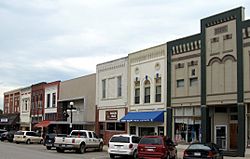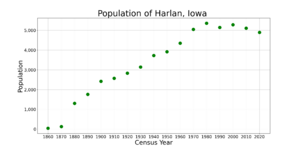Harlan, Iowa facts for kids
Quick facts for kids
Harlan, Iowa
|
|
|---|---|

Downtown Harlan
|
|

Location of Harlan, Iowa
|
|
| Country | |
| State | |
| County | Shelby |
| Area | |
| • Total | 4.42 sq mi (11.45 km2) |
| • Land | 4.42 sq mi (11.45 km2) |
| • Water | 0.00 sq mi (0.00 km2) |
| Elevation | 1,273 ft (388 m) |
| Population
(2020)
|
|
| • Total | 4,893 |
| • Density | 1,107.26/sq mi (427.48/km2) |
| Time zone | UTC-6 (Central (CST)) |
| • Summer (DST) | UTC-5 (CDT) |
| ZIP codes |
51537, 51593
|
| Area code(s) | 712 |
| FIPS code | 19-34500 |
| GNIS feature ID | 468007 |
Harlan is a city and the county seat of Shelby County, Iowa, along the West Nishnabotna River. The population was 4,893 at the time of the 2020 census.
Contents
History
Harlan was platted in 1858. It was named for one of Iowa's early U.S. Senators, James Harlan. Harlan was designated county seat in 1859. The town was incorporated on May 2, 1879.
Geography
According to the United States Census Bureau, the city has a total area of 4.39 square miles (11.37 km2), all of it land.
Climate
| Climate data for Harlan, Iowa, 1991–2020 normals, extremes 1899–2016 | |||||||||||||
|---|---|---|---|---|---|---|---|---|---|---|---|---|---|
| Month | Jan | Feb | Mar | Apr | May | Jun | Jul | Aug | Sep | Oct | Nov | Dec | Year |
| Record high °F (°C) | 68 (20) |
71 (22) |
90 (32) |
94 (34) |
106 (41) |
107 (42) |
114 (46) |
111 (44) |
106 (41) |
94 (34) |
80 (27) |
68 (20) |
114 (46) |
| Mean maximum °F (°C) | 51.5 (10.8) |
57.5 (14.2) |
73.3 (22.9) |
85.3 (29.6) |
88.8 (31.6) |
93.4 (34.1) |
94.4 (34.7) |
93.4 (34.1) |
89.9 (32.2) |
82.5 (28.1) |
68.2 (20.1) |
53.0 (11.7) |
96.5 (35.8) |
| Mean daily maximum °F (°C) | 30.7 (−0.7) |
35.7 (2.1) |
49.9 (9.9) |
63.3 (17.4) |
74.1 (23.4) |
83.6 (28.7) |
85.9 (29.9) |
84.0 (28.9) |
78.5 (25.8) |
65.4 (18.6) |
49.3 (9.6) |
35.9 (2.2) |
61.4 (16.3) |
| Daily mean °F (°C) | 20.5 (−6.4) |
24.7 (−4.1) |
37.6 (3.1) |
49.8 (9.9) |
61.7 (16.5) |
71.7 (22.1) |
74.7 (23.7) |
72.4 (22.4) |
65.1 (18.4) |
52.2 (11.2) |
37.6 (3.1) |
25.8 (−3.4) |
49.5 (9.7) |
| Mean daily minimum °F (°C) | 10.3 (−12.1) |
13.7 (−10.2) |
25.3 (−3.7) |
36.4 (2.4) |
49.3 (9.6) |
59.9 (15.5) |
63.6 (17.6) |
60.8 (16.0) |
51.7 (10.9) |
39.1 (3.9) |
25.9 (−3.4) |
15.7 (−9.1) |
37.6 (3.1) |
| Mean minimum °F (°C) | −10.1 (−23.4) |
−7.4 (−21.9) |
5.9 (−14.5) |
21.1 (−6.1) |
35.7 (2.1) |
46.9 (8.3) |
51.7 (10.9) |
49.7 (9.8) |
34.9 (1.6) |
22.9 (−5.1) |
9.1 (−12.7) |
−6.5 (−21.4) |
−16.1 (−26.7) |
| Record low °F (°C) | −37 (−38) |
−37 (−38) |
−23 (−31) |
2 (−17) |
18 (−8) |
31 (−1) |
40 (4) |
35 (2) |
20 (−7) |
0 (−18) |
−16 (−27) |
−27 (−33) |
−37 (−38) |
| Average precipitation inches (mm) | 0.90 (23) |
0.98 (25) |
2.05 (52) |
3.34 (85) |
4.74 (120) |
5.17 (131) |
3.72 (94) |
4.32 (110) |
4.00 (102) |
2.37 (60) |
1.43 (36) |
1.31 (33) |
34.33 (871) |
| Average snowfall inches (cm) | 7.6 (19) |
7.6 (19) |
4.0 (10) |
1.5 (3.8) |
0.0 (0.0) |
0.0 (0.0) |
0.0 (0.0) |
0.0 (0.0) |
0.0 (0.0) |
0.9 (2.3) |
2.2 (5.6) |
6.7 (17) |
30.5 (76.7) |
| Average precipitation days (≥ 0.01 in) | 5.8 | 6.7 | 7.4 | 10.9 | 12.2 | 11.1 | 8.7 | 8.8 | 7.3 | 7.5 | 5.7 | 6.2 | 98.3 |
| Average snowy days (≥ 0.1 in) | 4.6 | 5.0 | 2.1 | 0.9 | 0.0 | 0.0 | 0.0 | 0.0 | 0.0 | 0.3 | 1.8 | 4.4 | 19.1 |
| Source 1: NOAA | |||||||||||||
| Source 2: National Weather Service (mean maxima/minima 1981–2010) | |||||||||||||
Demographics
| Historical populations | ||
|---|---|---|
| Year | Pop. | ±% |
| 1860 | 47 | — |
| 1870 | 128 | +172.3% |
| 1880 | 1,304 | +918.8% |
| 1890 | 1,765 | +35.4% |
| 1900 | 2,422 | +37.2% |
| 1910 | 2,570 | +6.1% |
| 1920 | 2,831 | +10.2% |
| 1930 | 3,145 | +11.1% |
| 1940 | 3,727 | +18.5% |
| 1950 | 3,915 | +5.0% |
| 1960 | 4,350 | +11.1% |
| 1970 | 5,049 | +16.1% |
| 1980 | 5,357 | +6.1% |
| 1990 | 5,148 | −3.9% |
| 2000 | 5,282 | +2.6% |
| 2010 | 5,106 | −3.3% |
| 2020 | 4,893 | −4.2% |
| Source: and Iowa Data Center Source: |
||
2020 census
At the 2020 census there were 4,893 people, 2,288 households, and 1,275 families living in the city. The population density was 1,111.6 inhabitants per square mile (429.2/km2). There were 2,348 housing units at an average density of 534.9 per square mile (206.5/km2). The racial makeup of the city was 90.8% White, 0.8% African American, 0.5% Native American, 0.8% Asian, 2.5% from other races, and 4.3% from two or more races. Hispanic or Latino of any race were 4.6%.
Of the 2,288 households, 21.5% had children under the age of 18 living with them, 45.3% were married couples living together, 7.5% had a female householder with no husband present, 3.0% had a male householder with no wife present, and 44.3% were non-families. 37.0% of households were one person and 17.9% were one person aged 65 or older. The average household size was 2.07 and the average family size was 2.75.
The median age was 47.4 years. 20.3% of residents were under the age of 18; 29.2% were between the ages of 15 and 44; and 25.0% were 65 years or older. The gender makeup of the city was 43.5% male and 53.7% female.
2010 census
At the 2010 census there were 5,106 people, 2,222 households, and 1,341 families living in the city. The population density was 1,163.1 inhabitants per square mile (449.1/km2). There were 2,410 housing units at an average density of 549.0 per square mile (212.0/km2). The racial makeup of the city was 97.0% White, 0.5% African American, 0.4% Native American, 0.6% Asian, 0.6% from other races, and 0.9% from two or more races. Hispanic or Latino of any race were 1.9%.
Of the 2,222 households, 26.7% had children under the age of 18 living with them, 47.8% were married couples living together, 9.7% had a female householder with no husband present, 2.8% had a male householder with no wife present, and 39.6% were non-families. 34.2% of households were one person and 17.7% were one person aged 65 or older. The average household size was 2.26 and the average family size was 2.88.
The median age was 43.8 years. 23.8% of residents were under the age of 18; 6.1% were between the ages of 18 and 24; 21.4% were from 25 to 44; 27% were from 45 to 64; and 21.8% were 65 or older. The gender makeup of the city was 46.4% male and 53.6% female.
Economy
A major Harlan employer is CDS Global, the Des Moines-based fulfillment house owned by the Hearst media conglomerate. Since this company provides subscription services for hundreds of periodicals, it is common to see a Harlan P.O. box as a magazine's customer service address.
Education
Primary or secondary schools
Public schools in Harlan are governed and operated by the Harlan Community School District. The school district also serves residents of Jacksonville, Corley, Defiance, Panama, Portsmouth, Earling, and Westphalia. As of November 2021, the district has a student enrollment of 1,450. The district's racial demographics are 91.4% White, 5.7% Hispanic, 0.8% African American, and 2% non-white of other minorities.
The district operates four schools spread amongst two campuses, all in Harlan:
- Harlan Primary School (K-2)
- Harlan Intermediate School (3-5)
- Harlan Community Middle School (6-8)
- Harlan Community High School (9-12)
Shelby County Catholic School is a private primary and elementary school in Harlan, Iowa. A department of St Michael's Catholic Church, it is the only private school in Harlan.
Notable people
- Johnny Beauchamp, NASCAR driver with two career Cup Series wins
- Mary Lincoln Beckwith, great-grandchild of Abraham Lincoln
- Howard Webster Byers, Iowa Attorney General
- Susan Christensen, Iowa Supreme Court Chief Justice
- Billy Cundiff, NFL kicker
- Zach Daeges, baseball outfielder
- George Sabin Gibbs, United States Army General
- Albert Hansen, college football coach
- Kij Johnson, author
- Greg Lansing, former Indiana State Sycamores men's basketball coach
- Jerry L. Larson, Iowa Supreme Court Justice
- Tiny Lund (1929–1975) NASCAR driver and 1963 winner of the Daytona 500
- Raymond Eugene Plummer, lawyer and judge
- Lynn Reynolds, film director
See also
 In Spanish: Harlan (Iowa) para niños
In Spanish: Harlan (Iowa) para niños


